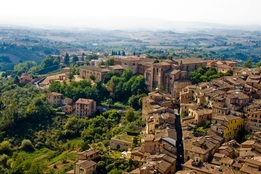 Our recent pilgrimage to Siena, spread out over two weekends, was undoubtedly one of the profound experiences of our lives. From the moment we stepped off the bus, Jhan and I felt the powerful pull of the city. Although we recognized it as the home of Saint Catherine, we knew little else about Siena before our arrival. The beauty of the city is an undeniable part of its attraction. Siena sits on three hills with a lush valley running through the center and some of Tuscany's most verdant farmland surrounding it. But underlying the ravishing vistas was something far more compelling.  Our first stop was the Basilica of San Domenico, which houses two of the most astonishing relics we have ever come across: St. Catherine's head and her thumb. The head sits in a small side chapel within an ornate reliquary, surrounded by frescoes depicting various scenes from Catherine's life. About 20 feet away is a glass case in which the thumb is displayed, along with a few other artifacts that reveal the intensity of Catherine's spiritual devotion and practice. These include a leather thong with which she would flagellate herself and a small marble altar used in her daily Communion ritual. 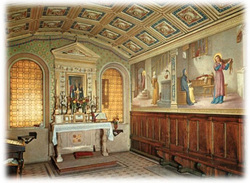 A short distance from San Domenico is Catherine's childhood home, which has been turned into a sanctuary consisting of three oratories. Our favorite of these is the bedroom oratory, which has powerful images from Catherine's life. The picture on the left includes an image of her purportedly levitating in the presence of her awestruck mother. As a child, Catherine would climb the stairs of the house while praying, and on more than one occasion she seemed to be lifted up in the air so that her feet were no longer touching the ground. Catherine began to have visions of Jesus at age five or six, which increased in frequency and intensity as she got older. Several of the paintings in the oratory depict these visions, including one of her mystical marriage with Jesus. Catherine viewed Jesus not just as her spouse but as her sacred lover. Her confessor and biographer, Blessed Raymond of Capua, wrote that Catherine's perceived marriage was "a fusion with Christ's physicality." To her family--especially her mother--this form of spiritual expression was seen as scandalous, as was Catherine's decision to reject both conventional marriage and the life of a nun. In every way, Catherine managed to live well outside the conventions and social norms of 14th Century Siena. 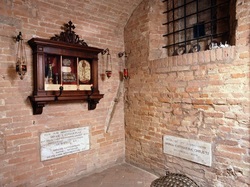 At the age of seven, Catherine vowed to give her life to God; she then retreated to a small cell in the basement of her parent's home. This cell can be viewed through a metal grille at the rear of the bedroom oratory. On the floor is a stone mound (covered with a protective mesh) that served as her pillow. The cell also contains a glass case displaying several artifacts, including Catherine's lantern and a piece of her veil. During her adolescence, Catherine spent three years in near seclusion and almost continuous silence here. When we walked into the bedroom oratory, we could feel Catherine's inspiring presence and divine passion.  During our time in the oratory, we encountered a small and very spirited group of nuns. A few of them were whispering and giggling like schoolgirls. We later discovered that they belonged to an order of nuns known as the Sisters of the Poor of Saint Catherine. When we visited their church, not only did we receive a warm and loving welcome but also a tour of the church, which holds the sarcophagus of their founder as well as one of the most remarkable images of Catherine ever painted. This image captures one of the moments of rapture that she spontaneously experienced throughout her life. One of the priests who observed Catherine in rapture wrote, "She was so alienated from her senses and so rigid that it would have been easier to break her body than to bend it." Later in life, Catherine was able to communicate verbally during such experiences, and she dictated an entire theological treatise, The Dialogue, while completely absorbed in divine ecstasy. In this treatise, Catherine presents a dialogue between God and herself, in which God offers specific instruction about how one experiences divine communion. Essentially, it is a how-to manual for those of us seeking not just to experience rapture but to live in this condition in a lasting manner.  For me, Catherine's greatest legacy is her rapture. She loved Jesus like few others have ever loved him--as a divine husband and lover. For many, her passionate love of Jesus was distasteful. Catholic scholars have tried to downplay certain aspects of it. For instance, some of Catherine's biographers have written that she received a ring of gold and jewels during her vision of mystical marriage to Jesus, when in fact what she envisioned receiving was the ring of his foreskin. Catherine also envisioned Jesus pulling her heart out of her chest and replacing it with his own. The intensity and intimacy of Catherine's love for Jesus exemplifies something that few saints--either Eastern or Western--have ever displayed. Many saints are an embodiment of the divine father or divine mother. Catherine was undoubtedly the divine lover.  This passion for the divine is reminiscent of the tantric yogis we encountered in India, whose spiritual path involves throwing themselves heart and soul into the flow of life. Clearly, there are differences in approach, but to me these differences seem to be a matter of culture. The time and place in which we are born have an undeniable influence on our spiritual lives, and yet at the core of these lives is something that is transcendent and universal. We seek to connect with the ultimate essence of our reality and consciousness, which is infinitely compelling and beautiful and also so vastly mysterious that it cannot be grasped by our intellect but only known through direct and immediate experience. Any name we give this essence seems to alienate someone. It's time to find a spirituality that is so inclusive that even the most steadfast atheist can ascribe to it. And so we shall call this essence, simply, life and the direct experience of it rapture. Yes, I realize that rapture has all kinds of connotations and has become associated with the notion, especially popular among fundamentalist Christians, that a righteous few will be transported to heaven during the second coming of Christ. But even that use of the word conveys the notion of being swept up in something joyful and profound. 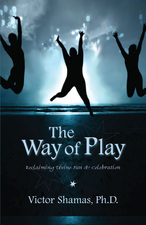 The desire to find a spiritual approach that finds common ground among people with disparate beliefs and cultural backgrounds has been the driving force in my life for the past decade. It has led me to find the spiritual community of my dreams through Global Chant. As many of you know, Global Chant is one of the fundamental passions of my life, and so nothing I say here is intended to minimize its value or my connection to it. But Global Chant is not for everyone. There are those who are turned off by the very idea of chanting, of uttering the divine name in any language--let alone many languages in one session! Could there be an even more universal spirituality than Global Chant? The pursuit of an answer to this question led to The Way of Play and the establishment of PlayHaven. There are various ways that I personally can have the same profound connection with the divine that we experience together when we chant as a group. The experience comes through different forms of play, many of which do not involve words or verbal communication of any kind. Here in Italy, I have immersed myself in this form of expression with a group of University of Arizona students that views spirituality of any kind as aversive. Yet we have shared moments of rapture just by sitting out in nature together, running around in a park, laughing together, sharing meals, or exploring the world with our five senses.  One of the surprising things I discovered, when I started speaking and writing about play as a spiritual path, is that play is not universally accepted. The American work ethic has led play to be seen as frivolous, childish, and irresponsible. I actually encountered hostility when I would give talks or lead play circles. So, I admit that even play may not be universal enough. Our time in Italy is leading me to the realization that the simplest and purest form of spirituality is one that focuses on the pure experience of life. For Italians, Catholicism may be the national religion, but spiritual life revolves around simple passions such as food, family, natural beauty, art, and leisurely strolls. Italy has introduced us to fascinating contrasts: the ritual of the three-hour meal and the ascetic lifestyle of Saint Catherine. Both are essentially leading to the same experience: an immersion into the flow of life and the very source of that flow. Regardless of what we believe or how we approach life, we all welcome the sensation of losing ourselves in something vast and beautiful. This sensation is rapture. And so, in honor of the spirit of Saint Catherine and of the Italian epicurean sensibility, I offer this simple invocation: Here is life. Let it fill me. I am consumed by rapture that sweeps me away and carries me home. I envelop the universe in an embrace that extends beyond time. Beyond space. Beyond self. I am life.
4 Comments
Jorge L Porrata
11/6/2013 08:07:26 am
That's it my brother, just flowing and being present: full with the weight and lightness of our very existence, connected with all what it is! Much love to both of you, Jorge and family
Reply
Carol Maun
11/9/2013 02:41:06 am
Hi Victor:
Reply
Martha Vollenweider
11/9/2013 11:53:01 pm
I find the whole discussion so fascinating. Identifying spirituality universal to all. Thanks for the exploration.
Reply
Lynne
7/8/2018 05:04:50 pm
Shamas - Jesus said "I am the Way, the Truth, and the Life." Catherine of Siena knew him as the living Word who was in the beginning, is now, and ever shall be - world without end. Amen!
Reply
Leave a Reply. |
I want to hear from you! Please share your questions and comments. And sign up for my newsletter, where I will pass along the insights, ideas, and inspiration that come my way.
Contact me:Archives
November 2023
|
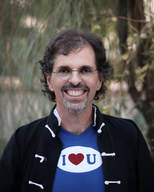
 RSS Feed
RSS Feed
